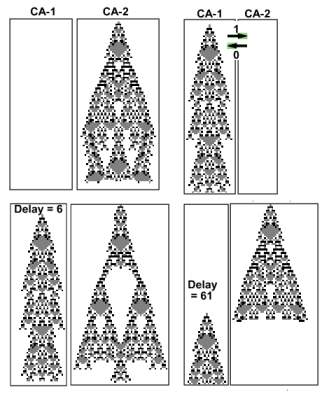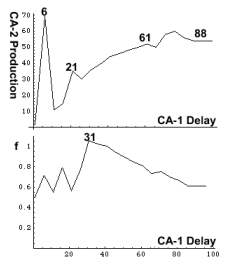 |
Non linear switch
This experiment describes the interaction between two CAs.
Their mutual impact = { 1, 0 }. CA-1 affects CA-2 and is not affected by it. In the first two frames only CA-2
was planted and the space of CA-1 is empty. CA-2 lives 88 days and then
dies.
 |
The relationship between the delay of CA-1 seeding and CA-2 cell production
is depicted in the first graph.
 |
Turnover
Imagine that after planting a zygote the CA grows to its
maximal size an then dies this is defined as turnover. In the first
frame couple a CA-2 zygote matured in 88 days and then died. During this
period it produced 54 cells. In
the third frame couple, CA-2
matured in 97 days and produced 69 cells
In the last frame couple CA-2 matured in 62 days and produced
52 cells.
Efficiency
How to set the system so as to get the highest cell yield
in the shortest time? We have to maximize the fraction f = (cell production)/
(turnover time). At delay = 6,
CA-2 matures in 97 days. During this period it produces 69 cells.
f = 69/97 = 0.71 At delay = 61, f = 52/61 = 0.86. The lower graph indicates that f
reaches its maximum at delay = 31.
Further reading:
When to harvest a CA?